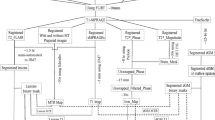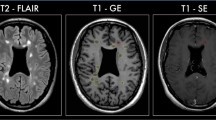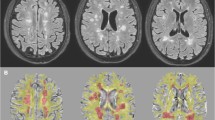Abstract
Histopathological and magnetic resonance imaging (MRI) studies have shown white matter (WM) damage in early stages of multiple sclerosis (MS) beyond the apparent T2-hyperintense lesions. These changes in normal appearing WM (NAWM) are important with regard to the clinical picture and prognosis. However, the detection of changes within NAWM has so far required special imaging techniques commonly not available in clinical routine and, hence, at large scale. The purpose of this study was to detect MS-related damage of NAWM by conventional MRI. As, within NAWM, the myelin content mainly drives the T1-weighted (T1w) signal, we scaled it by the T2w signal. We tested the hypothesis that the mean T1w/T2w ratio of NAWM is decreased in MS compared to healthy controls (HC) and that it correlates with clinical measures. We developed a pipeline to determine the individual mean values of this ratio within NAWM. We studied 244 patients in early disease stages of MS (mean age 37 ± 10 years, mean disease duration 3.1 ± 2.3, Expanded Disability Status Scale 1.3 ± 1), and 78 HC (mean age 31 ± 8 years). Compared to HC, the mean T1w/T2w ratio was lowered in the patient group (P < 0.001). The difference remained significant after restricting the analysis to patients with a disease duration of 5 years or less and without disease modifying drugs. Our measures also correlated with clinical scores. We believe that the mean T1w/T2w ratio is a promising candidate to assess MS-related tissue damage within NAWM at large scale.


Similar content being viewed by others
References
Barkhof F (2002) The clinico-radiological paradox in multiple sclerosis revisited. Curr Opin Neurol 15:239–245
Bonnier G, Roche A, Romascano D, Simioni S, Meskaldji D, Rotzinger D, Lin YC, Menegaz G, Schluep M, Du Pasquier R, Sumpf TJ, Frahm J, Thiran JP, Krueger G, Granziera C (2014) Advanced MRI unravels the nature of tissue alterations in early multiple sclerosis. Ann Clin Transl Neurol 1:423–432
Moll NM, Rietsch AM, Thomas S, Ransohoff AJ, Lee JC, Fox R, Chang A, Ransohoff RM, Fisher E (2011) Multiple sclerosis normal-appearing white matter: pathology-imaging correlations. Ann Neurol 70:764–773
Giannetti P, Politis M, Su P, Turkheimer FE, Malik O, Keihaninejad S, Wu K, Waldman A, Reynolds R, Nicholas R, Piccini P (2015) Increased PK11195-PET binding in normal-appearing white matter in clinically isolated syndrome. Brain 138:110–119
Barkovich AJ (2000) Concepts of myelin and myelination in neuroradiology. AJNR Am J Neuroradiol 21:1099–1109
Glasser MF, Van Essen DC (2011) Mapping human cortical areas in vivo based on myelin content as revealed by T1- and T2-weighted MRI. J Neurosci 31:11597–11616
Chard DT, Jackson JS, Miller DH, Wheeler-Kingshott CA (2010) Reducing the impact of white matter lesions on automated measures of brain gray and white matter volumes. J Magn Reson Imaging 32:223–228
Schmidt P, Gaser C, Arsic M, Buck D, Forschler A, Berthele A, Hoshi M, Ilg R, Schmid VJ, Zimmer C, Hemmer B, Muhlau M (2012) An automated tool for detection of FLAIR-hyperintense white-matter lesions in Multiple Sclerosis. Neuroimage 59:3774–3783
Mühlau M, Buck D, Förschler A, Boucard CC, Arsic M, Schmidt P, Gaser C, Berthele A, Hoshi M, Jochim A, Kronsbein H, Zimmer C, Hemmer B, Ilg R (2013) White-matter lesions drive deep gray-matter atrophy in early multiple sclerosis: support from structural MRI. Mult Scler 19:1485–1492
Polman CH, Reingold SC, Banwell B, Clanet M, Cohen JA, Filippi M, Fujihara K, Havrdova E, Hutchinson M, Kappos L, Lublin FD, Montalban X, O’Connor P, Sandberg-Wollheim M, Thompson AJ, Waubant E, Weinshenker B, Wolinsky JS (2011) Diagnostic criteria for multiple sclerosis: 2010 Revisions to the McDonald criteria. Ann Neurol 69:292–302
Kurtzke JF (1983) Rating neurologic impairment in multiple sclerosis: an expanded disability status scale (EDSS). Neurology 33:1444–1452
Leray E, Yaouanq J, Le Page E, Coustans M, Laplaud D, Oger J, Edan G (2010) Evidence for a two-stage disability progression in multiple sclerosis. Brain 133:1900–1913
Fischer JS, Rudick RA, Cutter GR, Reingold SC (1999) The Multiple Sclerosis Functional Composite Measure (MSFC): an integrated approach to MS clinical outcome assessment. National MS Society Clinical Outcomes Assessment Task Force. Mult Scler 5:244–250
Cutter GR, Baier ML, Rudick RA, Cookfair DL, Fischer JS, Petkau J, Syndulko K, Weinshenker BG, Antel JP, Confavreux C, Ellison GW, Lublin F, Miller AE, Rao SM, Reingold S, Thompson A, Willoughby E (1999) Development of a multiple sclerosis functional composite as a clinical trial outcome measure. Brain 122(Pt 5):871–882
Yildiz M, Tettenborn B, Radue EW, Bendfeldt K, Borgwardt S (2014) Association of cognitive impairment and lesion volumes in multiple sclerosis—a MRI study. Clin Neurol Neurosurg 127C:54–58
Penner IK, Naegelin Y, Kappos L, Calabrese P (2009) MUSIC (Multiple Sclerosis Inventory Cognition): a new screening instrument to assess MS-related cognitive impairment. Mult Scler 15:S117
Lassmann H, Bruck W, Lucchinetti CF (2007) The immunopathology of multiple sclerosis: an overview. Brain Pathol 17:210–218
Filippi M, Rocca MA, Martino G, Horsfield MA, Comi G (1998) Magnetization transfer changes in the normal appearing white matter precede the appearance of enhancing lesions in patients with multiple sclerosis. Ann Neurol 43:809–814
Samann PG, Knop M, Golgor E, Messler S, Czisch M, Weber F (2012) Brain volume and diffusion markers as predictors of disability and short-term disease evolution in multiple sclerosis. AJNR Am J Neuroradiol 33:1356–1362
Fernando KT, Tozer DJ, Miszkiel KA, Gordon RM, Swanton JK, Dalton CM, Barker GJ, Plant GT, Thompson AJ, Miller DH (2005) Magnetization transfer histograms in clinically isolated syndromes suggestive of multiple sclerosis. Brain 128:2911–2925
Liu Z, Pardini M, Yaldizli O, Sethi V, Muhlert N, Wheeler-Kingshott CA, Samson RS, Miller DH, Chard DT (2015) Magnetization transfer ratio measures in normal-appearing white matter show periventricular gradient abnormalities in multiple sclerosis. Brain 138:1239–1246
Stephenson E, Nathoo N, Mahjoub Y, Dunn JF, Yong VW (2014) Iron in multiple sclerosis: roles in neurodegeneration and repair. Nat Rev Neurol 10:459–468
Eilaghi A, Kassner A, Sitartchouk I, Francis PL, Jakubovic R, Feinstein A, Aviv RI (2013) Normal-appearing white matter permeability distinguishes poor cognitive performance in processing speed and working memory. AJNR Am J Neuroradiol 34:2119–2124
Filippi M, Rocca MA, Benedict RH, DeLuca J, Geurts JJ, Rombouts SA, Ron M, Comi G (2010) The contribution of MRI in assessing cognitive impairment in multiple sclerosis. Neurology 75:2121–2128
Dineen RA, Vilisaar J, Hlinka J, Bradshaw CM, Morgan PS, Constantinescu CS, Auer DP (2009) Disconnection as a mechanism for cognitive dysfunction in multiple sclerosis. Brain 132:239–249
Traboulsee A, Dehmeshki J, Peters KR, Griffin CM, Brex PA, Silver N, Ciccarrelli O, Chard DT, Barker GJ, Thompson AJ, Miller DH (2003) Disability in multiple sclerosis is related to normal appearing brain tissue MTR histogram abnormalities. Mult Scler 9:566–573
Acknowledgments
This work was funded by the ‘Hertie Foundation’ (Grand P1140092 ‘Myelin mapping in MS’) and supported by the ‘German Competence Network Multiple Sclerosis’ (German Ministry for Research and Education Grand 01GI1307B).
Author information
Authors and Affiliations
Corresponding author
Ethics declarations
Conflicts of interest
The authors declare that there are no conflicts of interest.
Rights and permissions
About this article
Cite this article
Beer, A., Biberacher, V., Schmidt, P. et al. Tissue damage within normal appearing white matter in early multiple sclerosis: assessment by the ratio of T1- and T2-weighted MR image intensity. J Neurol 263, 1495–1502 (2016). https://doi.org/10.1007/s00415-016-8156-6
Received:
Revised:
Accepted:
Published:
Issue Date:
DOI: https://doi.org/10.1007/s00415-016-8156-6




